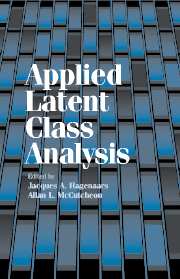Book contents
- Frontmatter
- Contents
- Contributors
- Preface
- INTRODUCTION
- CLASSIFICATION AND MEASUREMENT
- CAUSAL ANALYSIS AND DYNAMIC MODELS
- 8 Use of Categorical and Continuous Covariates in Latent Class Analysis
- 9 Directed Loglinear Modeling with Latent Variables: Causal Models for Categorical Data with Nonsystematic and Systematic Measurement Errors
- 10 Latent Class Models for Longitudinal Data
- 11 Latent Markov Chains
- UNOBSERVED HETEROGENEITY AND NONRESPONSE
- Appendix A: Notational Conventions
- Appendix B: Further Readings
- Appendix C: Selected Software; Webpage
- Index
9 - Directed Loglinear Modeling with Latent Variables: Causal Models for Categorical Data with Nonsystematic and Systematic Measurement Errors
Published online by Cambridge University Press: 31 July 2009
- Frontmatter
- Contents
- Contributors
- Preface
- INTRODUCTION
- CLASSIFICATION AND MEASUREMENT
- CAUSAL ANALYSIS AND DYNAMIC MODELS
- 8 Use of Categorical and Continuous Covariates in Latent Class Analysis
- 9 Directed Loglinear Modeling with Latent Variables: Causal Models for Categorical Data with Nonsystematic and Systematic Measurement Errors
- 10 Latent Class Models for Longitudinal Data
- 11 Latent Markov Chains
- UNOBSERVED HETEROGENEITY AND NONRESPONSE
- Appendix A: Notational Conventions
- Appendix B: Further Readings
- Appendix C: Selected Software; Webpage
- Index
Summary
INTRODUCTION
The founding fathers of Latent Class Analysis (LCA) have explained LCA mainly as a categorical latent structure model, that is, as a particular scaling model (Lazarsfeld, 1950; Lazarsfeld and Henry, 1969; Goodman, 1974a, 1974b; Haberman, 1974, 1979; Clogg, 1981a, 1995). LCA is used to measure the true scores on underlying, not directly observed, categorical variables by means of a set of observed categorical variables that function as the indicators of these underlying, latent variables. The indicators are not perfect measures of the latent variables, but they are subjected to “random,” nonsystematic errors that lead to probabilistic relationships between the latent variables and the indicators. The standard LCA assumption of local independence specifies that the errors are conditionally independent of each other, when one controls for the latent variables. Throughout this chapter, the local independence assumption will be denoted as the independent classification error (ICE) assumption. Interpreting particular conditional response probabilities in terms of probabilities of classification errors (also termed misclassifications) is most appropriate when the scores on an indicator directly depend on just one latent variable and when there is a one-to-one correspondence between the categories of the indicator and the latent variable (Sutcliffe, 1965a, 1965b; Hagenaars, 1990; Kuha and Skinner, 1997). (For LCA models in which the latent variable has just a few categories and the indicators have many more, see Clogg, 1981b; also see Chapter 4 in this volume).
- Type
- Chapter
- Information
- Applied Latent Class Analysis , pp. 234 - 286Publisher: Cambridge University PressPrint publication year: 2002
- 7
- Cited by



